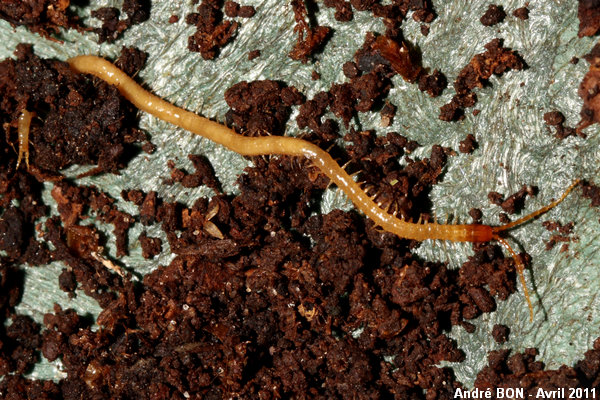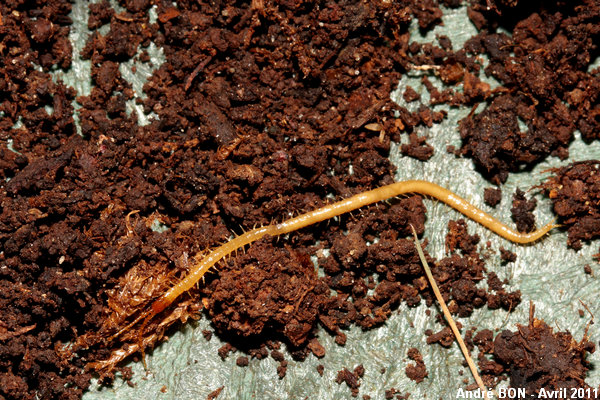

| Geophilus flavus (De Geer, 1778) |


|
|
Scientific name: Geophilus flavus (De Geer, 1778) Common name: Other names: Other scientific names: Geophilus longicornis, Necrophloeophagus longicornis. French name: Phylum: Arthropoda Class: Chilopoda Order: Geophilomorpha Family: Geophilidae Size: Up to 45 mm. Habitat: In the litter. Food: Woodlice, earth worms and other arthropods found in the soil. It kills its preys using its forcipules or venom claws. Reproduction: In spring, the male deposits a spermatophore, it is then taken up by the female. 50 to 60 eggs are laid in the leaf litter. Females take care of the eggs till hatching. Geographic area: Europe, introduced to North America and to Australia. |
Centipedes of the Chilopoda class show only one pair of legs per segment and one pair of venom claws or forcipules under the head. The Geophilomorpha order is characterized by more than 27 pairs of legs. The antennae have 14 articles. The Geophilidae and Schendylidae families are characterized by a head which is longer than wide and by a forcipular tergite (dorsal plate located at the back of the head and holding the forcipules) which is thinner, trapezoid-shaped, with straight edges, the smaller side at the front and the longer side at the rear. There are many species in these two families and a binocular exam is required to go further with species identification. However, in the northern part of France except on the seaside, all the species with more than 43 pairs of legs always belong to the Geophilidae family. Geophilus flavus shows 41 to 53 pairs of legs on males and 43 to 57 on females. You can tell it apart with its very long antennae, at least five time the head width, with elongated articles, at least twice as long as wide. It is usually a yellowish colour with a reddish head and reddish antennae. |
| [To know more about the Geophilus flavus] [Next picture] [Top] |

|
I have observed this centipede in my compost heap. I have been able to see the shape of the forcipular tergite by zooming on the full size picture. The length of the antennae and the shape of the articles are clearly visible on this picture. |
| [To know more about the Geophilus flavus] [Previous picture] [Top] |

|
It is quite impossible to count the pairs of legs on a moving centipede. This is much easier on a photo. I have counted 53 pairs of legs on this one. |